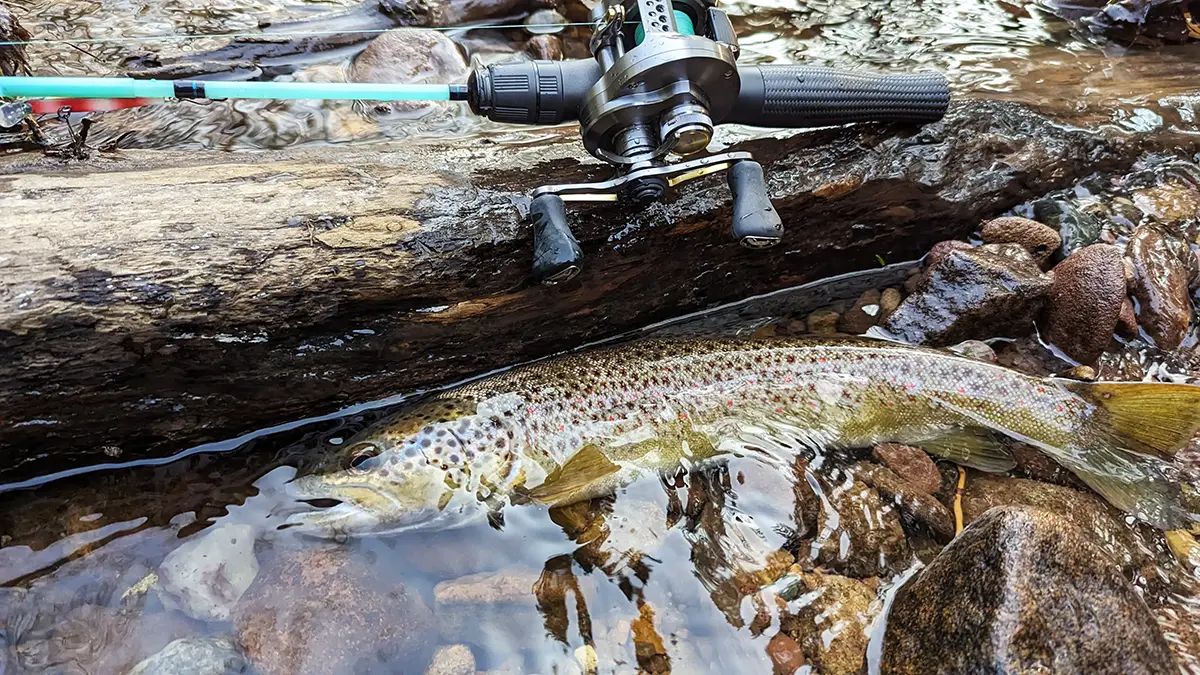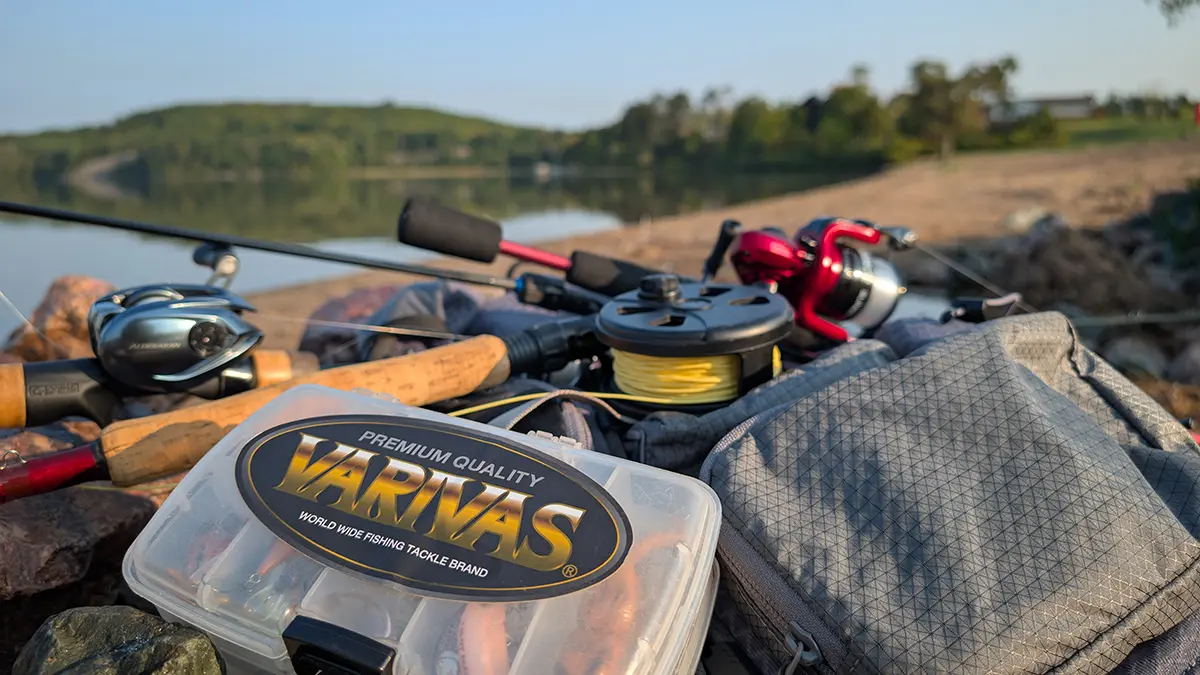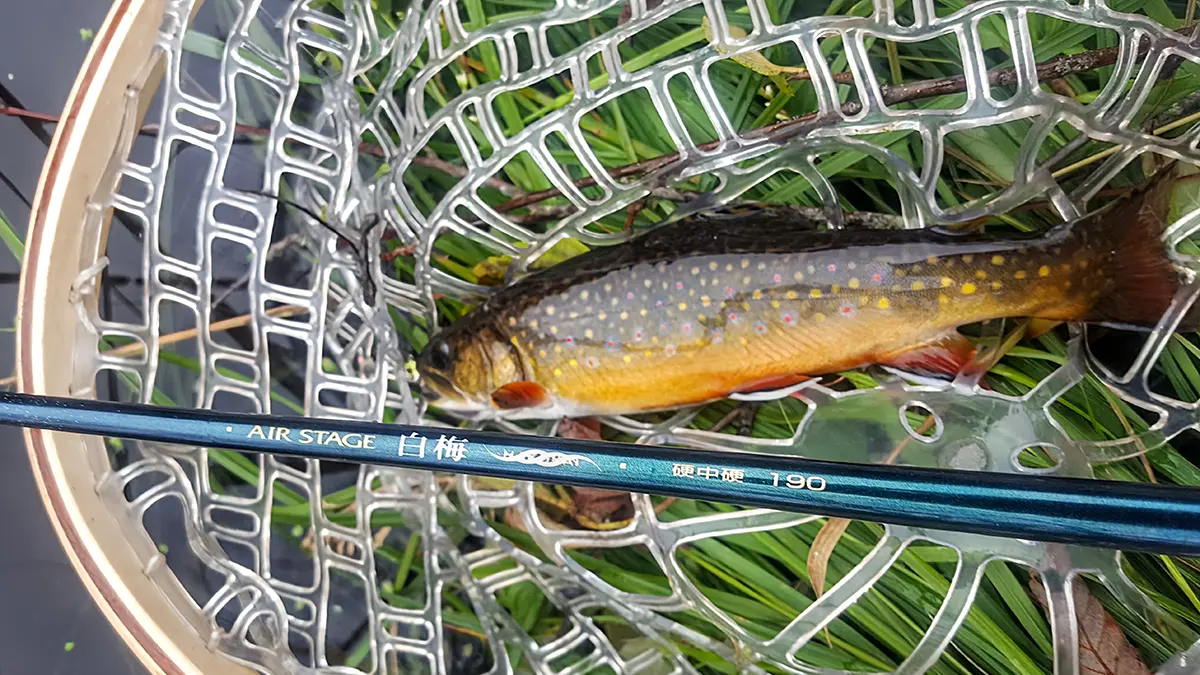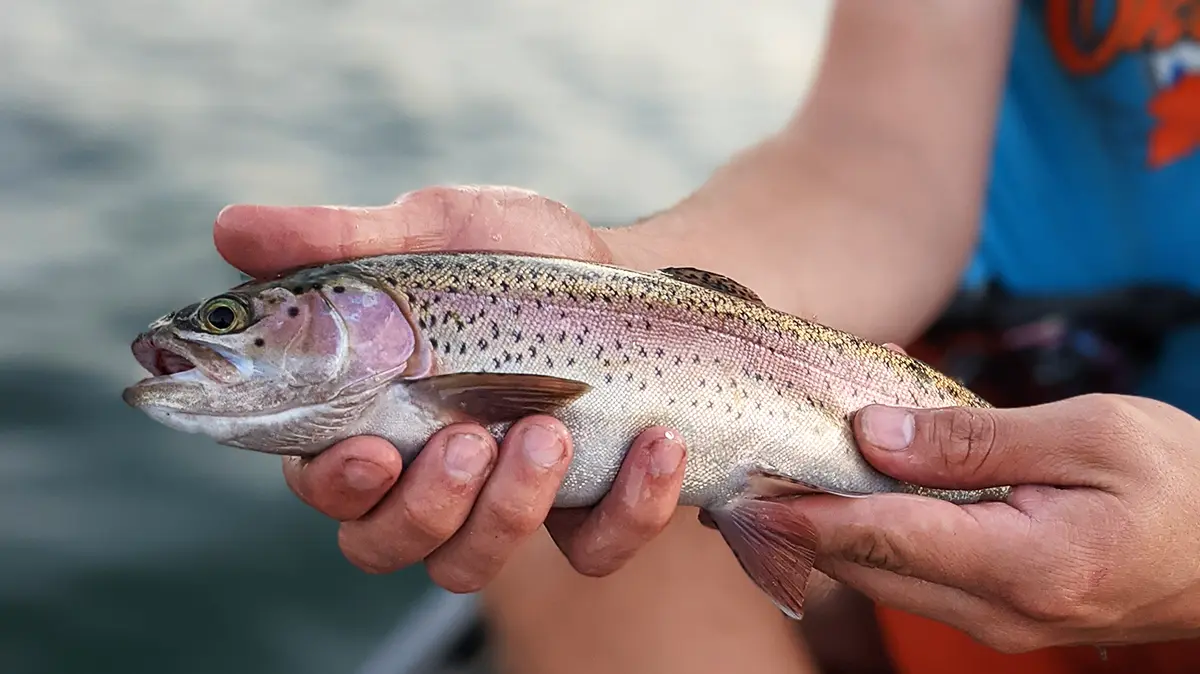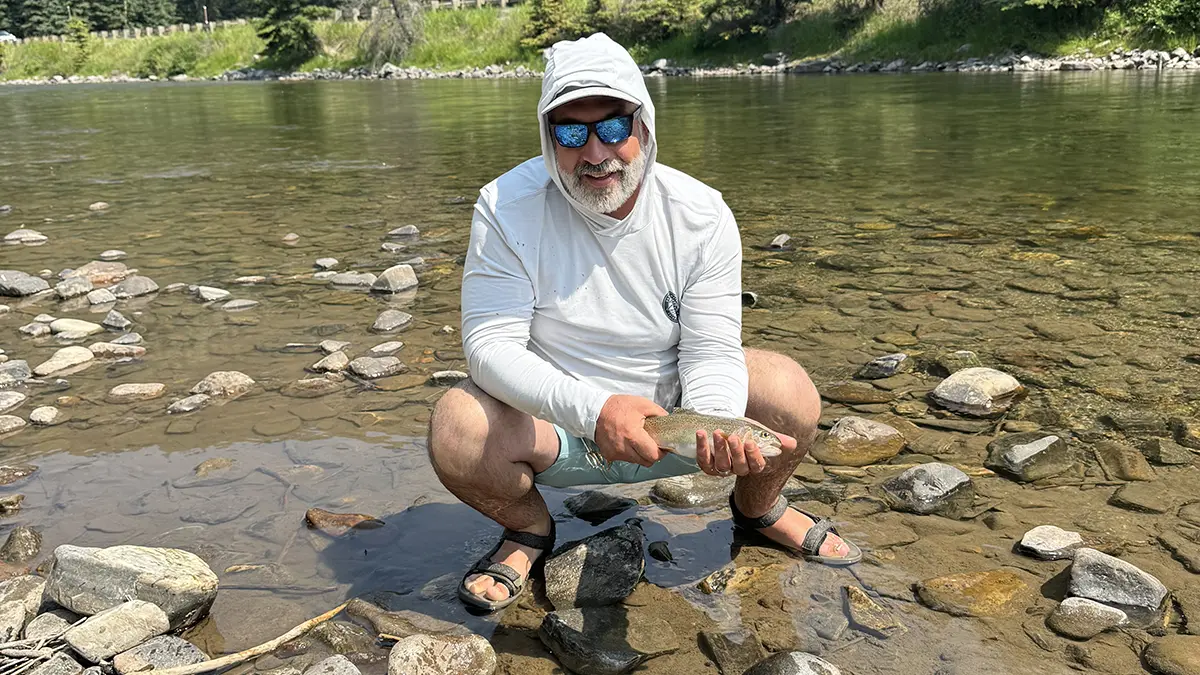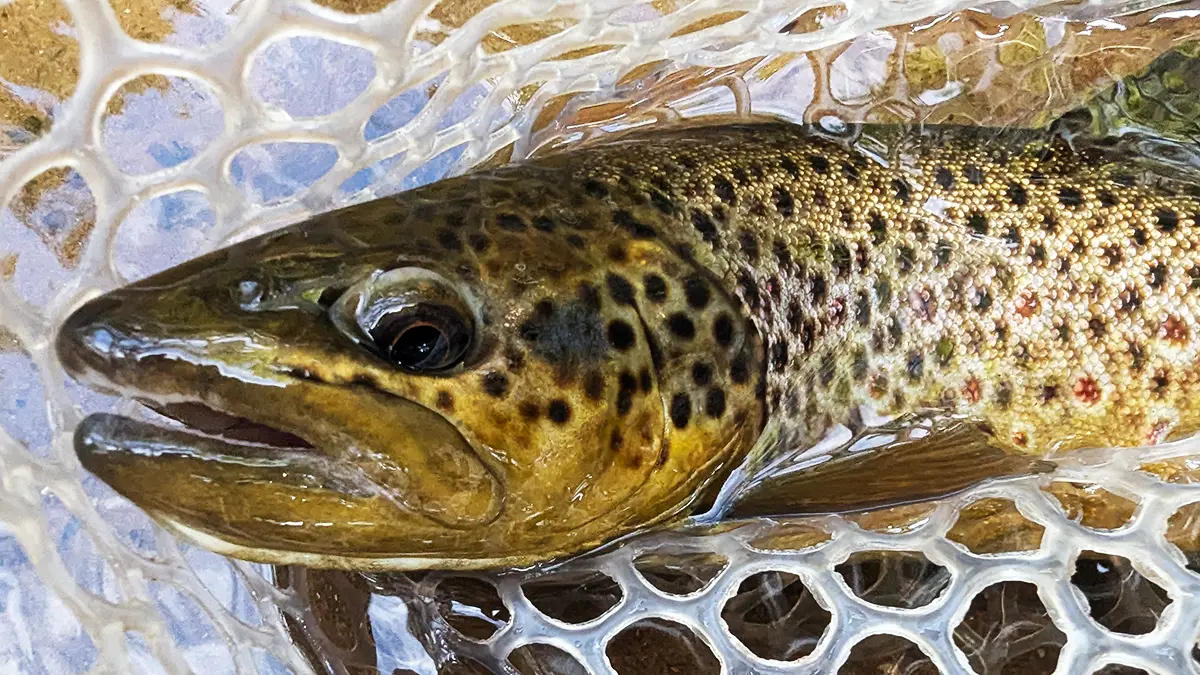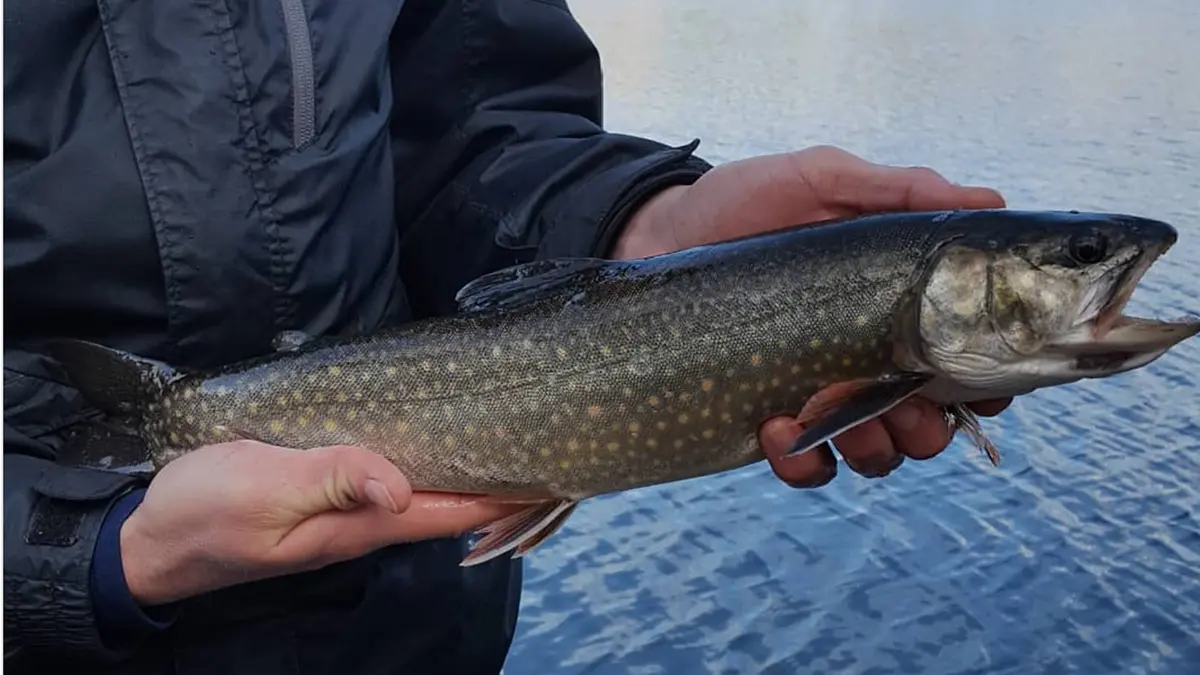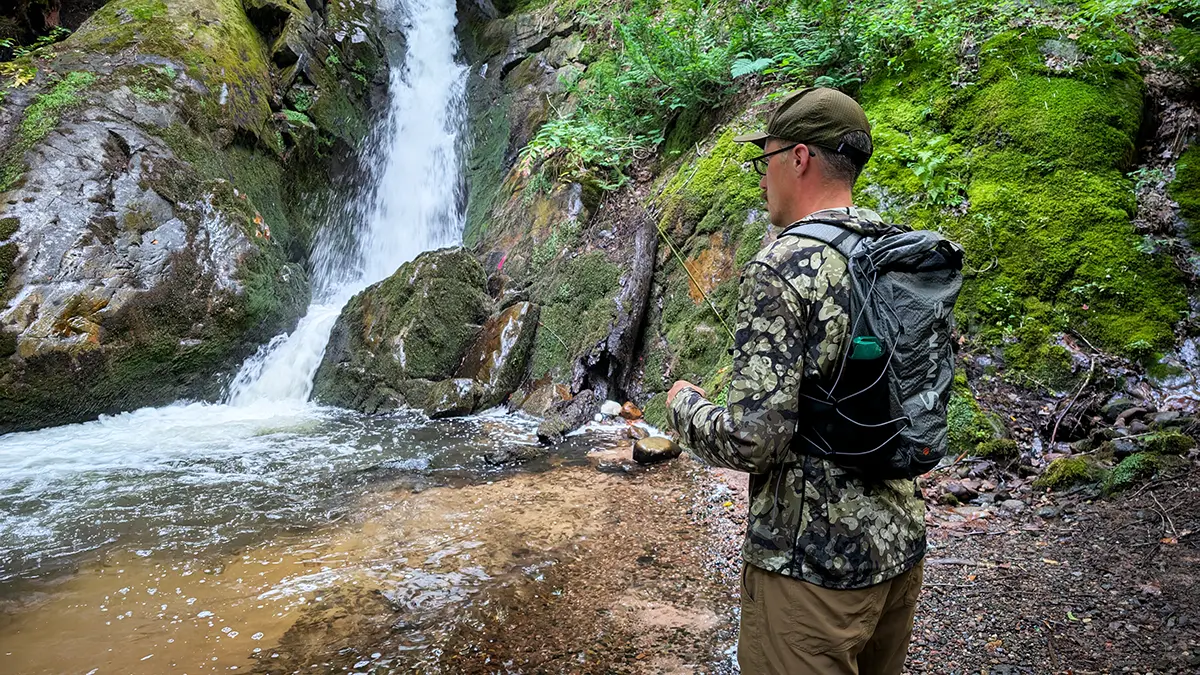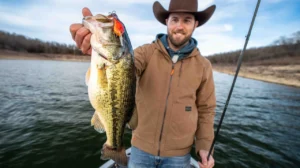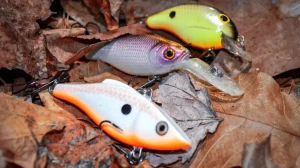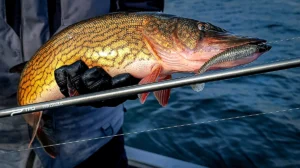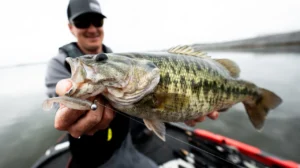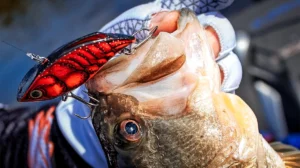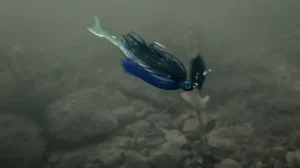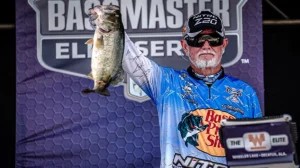Trout fishing does not have to be the “rich man’s sport” people make it out to be. I have seen many anglers with rods older than themselves catching all types of trout using the most basic of techniques and tackle. How we choose to catch these cold water carnivores is completely up to us. There are many variables that can lead to anglers being successful, and technique is only a small one. This guide is an intro to trout angling techniques with species highlights with a few interesting facts that will entertain novice and expert trout anglers alike.
SIMILARITIES WITH OTHER SPECIES
For years, I tossed trout fishing aside in favor of bass fishing. Frogging, punching and flipping for bass took up much of my time when hitting the waters. I became obsessed with learning new techniques and embraced the challenge of mastering the variables such as weather, water clarity and vegetation. I invested a lot of time and money into learning the wide range of techniques people use to catch bass. A few years passed and my focus shifted back to finesse fishing.
I found out about the bait finesse system (BFS) and that really blended my two passions in fishing, bass and finesse tactics. Quickly, I adopted BFS to trout fishing and really reinvigorated my love for trout. I brought the casting skills I learned bass fishing into the small, brush-lined streams. The deliberate thought and planning I put into my current bass fishing pursuits also made its way over to trout, and now I’m more productive than I ever was.
If you’re like me and returning to trout after a brief hiatus, or are turning to it for the first time, consider this your guide to getting started. We cover the habitat and habits of rainbow, brown, brook, lake trout and others, as well as offering a variety of methods for catching them. Read on to learn how to find these exciting species, and how to get them to bite.
HOW TO FIND TROUT WHERE YOU LIVE
I had to start from scratch to find where the trout waters were when I was visiting the East Coast this past winter. With limited time to fish, I had to make sure that I was going to hit waters that actually held fish. I started with online searches to give myself some direction when I was finally able to head out. After plenty of screen time, I ended up having to drive about an hour and a half to get to waters that were reported to consistently hold trout.
ONLINE RESEARCH
My research usually starts with a Google search of waters I see near my location with Google Maps. This gives me a rough idea as to what to search for when I am combing websites. Sites such as online forums are my favorite way to find new waters. Although often outdated, the rich level of detail you can find is incredible. This at least gives me a blood trail to follow for more information when asking local anglers about fishing spots.
IN PERSON
Local Trout Unlimited chapters are a great resource to get on the right path to find trout. They are stewards of responsible trout angling and will often share some spots to at least get you on the fish. Do not expect them to lay out a red carpet to the most productive section of the stream. You will still need to do the work to find fish within the stretches of river they may point out.
Fly shops are another great way to find waters that hold fish. Beyond pointing out a few streams to catch trout, they often inform anglers what lures/flies are working, the current water levels and other useful information. Many fly shops either have guiding services or, definitely know of a few guides that can get you on the water, greatly increasing your odds of finding fish.
GET SOCIAL
Lastly, social media is a great place to find the scoop on specific waters. Yes, as great as it is to disconnect from the world and purify yourself in the waters of a new stream, searching for hashtags of that river name, state or other key terms will get you on a path that can show the date, location and tackle used to catch fish. YouTube can also be a treasure trove of river knowledge, as many anglers will film their adventures and have the river name in the video title. You can see the date of the video and kind of guess the water flow, species and forage people use on those waters to catch fish.
You may also already have relationships with people that have a ton of knowledge of the waters you are seeking to fish. I can say I do not let my pride get in the way of finding fish, reaching out to people about their local waters and it has paid off. People also ask me about places to fish as well, so I return the favor most times. Of course, I don’t tell them all my secret spots!
TECHNIQUES FOR CATCHING TROUT
Now that we have found areas that hold trout, the next step is figuring out how to catch them. Every angler I talk with has their own little quirks to be successful on the water. I like to use a more aggressive approach to find trout, believing that I can catch more fish by covering water quickly using attractor-type lures than I can with finesse techniques. Sometimes, I end up doing a lot of hiking and far less fishing than anglers who took their time in a short stretch of the river. Luckily for me, I have learned to be more flexible and not as stubborn in my ways as I age. You should also be flexible in your tackle choices, as there are plenty of effective ways to catch trout.
CONVENTIONAL TACKLE
Conventional tackle, such as lures and live bait delivered with spinning or baitcasting gear, is arguably the easiest and simplest to learn. Most people started trout fishing using worms or spinners on a cheap spinning combo and had tons of fun doing so. The simplicity and versatility of conventional angling is why most people choose it — you can hit the stream with a pocketful of trout lures and catch them up.
FLY FISHING
I couldn’t write a technique section for trout without talking about fly fishing. Although trout sipping perfectly placed dry flies is textbook fly fishing, there are so many ways people take the basic principle of “casting your line, not the fly” and make it their own. From near microscopic forage imitations up to massive mouse patterns and streamers, fly fishing covers a wide array of bases to ensure “matching the hatch” happens. Fly anglers oftentimes are trying to imitate the seasonal forage in order to take those passive trout I may have missed ripping aggressive lures by and coaxing them into biting. On the other hand, brightly colored streamers and other flashy flies can trigger reaction strikes from even the most stubborn of fish.
Fly rods are classified by “weights” rather than being defined by power and action as conventional rods are. In a nutshell, fly rods are rated by the line that rod is intended to use, as that is what propels the fly. Lines are classified from 00 to 16 and up. The lower numbers are intended for tiny flies and small fish, and the largest are used for foot-long flies and gamefish. The most typical weights for trout fishing are 3 to 6, depending on the size of the prey being imitated and the size of the fish being targeted. If you are interested more in learning about fly fishing, check out our guide to fly fishing gear basics
TROLLING TACTICS
Common for upper Midwest and Great Lakes anglers, trolling is a great way to work large bodies of water. Unlike bass fishing, many trout waters are somewhat featureless and don’t have telltale signs of structure that hold fish. Trolling allows anglers to cover ground and find suspended fish that could be almost anywhere. It also is a good way to target fish that may be staging near river mouths before swimming upstream to spawn. Without going too deep down the rabbit hole, it is far more than drinking beer and aimlessly driving a boat until you get lucky. The amount of variables some anglers interpret in order to be consistently successful while trolling is arguably greater than any other type of fishing. That said, this is specialized technique limited to certain bodies of water.
VERTICAL JIGGING
This tactic is rapidly gaining popularity as it is a fun way for big water anglers to catch trout, primarily lakers, in deep water. In contrast to trolling, vertical jigging employs much lighter tackle. Anglers typically use 6- to 7-foot long spinning rods, and drop jigs weighing anywhere from 1/2 to 1 ounce or more onto schools of hungry fish. Modern electronics have made locating schools of bait or trout in deep, featureless waters easier than ever before, making this much more viable than in years past. You can read more about it in this article on vertical jigging for lake trout.
TARGETING DIFFERENT SPECIES OF TROUT
While we refer to all of the various species collectively as trout, each has its own unique characteristics. Understanding each species and how they behave is the key to catching them. We go over each variety and offer some tactics to catch them below. For an even more in-depth look, you can review our guide to the types of trout and how to identify them.
RAINBOW TROUT
One of the most widely distributed trout in North America, rainbows are originally from the West Coast of the United States and other Pacific Ocean coastlines. Now, rainbows have been stocked all over the world thanks to the ease in which they can be raised in captivity and qualities as table fare. You can find rainbows in bodies of water as big as the ocean, or as small as your local creek, providing it is cool enough.
Rainbow trout spawn in late winter/early spring and will travel great distances to reach suitable areas. Generally, the further upstream a fish is born, the better their chances of survival are, due to lack of predators and plentiful micro-forage for young trout to feed on. So they will travel incredible distances, sometimes hundreds of miles, to suitable areas to deposit their eggs.
Rainbow trout that have access to a larger body of water such as the Pacific Ocean or the Great Lakes are often called “steelhead,” though that term is debatable for Great Lakes rainbows. Lake-run rainbow trout, no matter how big they are or what they look like, are “adfluvial.” This is the correct term to identify fish that spawn in tributary streams where the young rear from 1 to 4 years before migrating to a lake system, where they grow to maturity, returning to streams to spawn. Whatever you call them, we can all agree that when rainbows have access to larger bodies of water, they turn into drag-peeling machines when they return to the rivers to spawn.
WAYS TO CATCH RAINBOW TROUT
A common and effective way to target steelhead is using rods between 9 and 14 feet (commonly called float rods) and drifting spawn sacs under floats. In case you’re not familiar, a spawn sac (like this example at Bass Pro) is a mesh bag filled with fish eggs. Spawning trout gobble these up, with some speculating they do so to eliminate competition for their own eggs. The approach might seem simple, but there are many intricacies that make the difference between multi-fish days and going multiple days without a fish. Fly anglers will also fish egg patterns or brightly-colored streamers, with varying success.
Rainbow trout that stay in one waterbody their whole lives seem much less picky than their cousins that are focused on ensuring the future of the population. They are generally more interested in eating, so they are more willing to hit a lure or fly. That doesn’t mean they’re pushovers, though. Many anglers will use smaller flies and more delicate presentations than they would for more aggressive species like brown trout. Speaking of flies, a good place to start are the ones outlined in our guide to best trout flies.
Anglers looking to target rainbows in streams or rivers with conventional tackle outside of spawning season should use spinning rods and lightweight lines. The length of the rod depends on the size of the waterway. Those fishing small, tight streams might want to use an ultralight rod anywhere from 4 foot 6 inches to 6 feet in length, paired with appropriately sized reel. Spinners are great here, as are worms and other small natural baits. Larger rivers call for longer rods, and those sized from 7 to 12 feet all have their place. Spinners, spoons, and even crankbaits can work well here.
STOCKED RAINBOW TROUT
Rainbow trout are so far-ranging because they are so easy to raise in captivity and transplant in the wild. Many rainbows are released in small ponds for anglers to enjoy. These fish can be very easy or very difficult to catch, depending on how many hooks they’ve seen since their worry-free life in the hatchery. I had to adjust my tactics quite a bit when fishing pressured stocked waters. I’ve had the most success when I stand far back from the shore and use very small tackle on light line. This turned many days of scratching my head into keeping my rod bent with consistent fish.
Wherever you find rainbows, and whatever tackle you use to target them, they are a worthy adversary. For more info on the natural history of this appealing species, check out our comprehensive guide to rainbow trout.

BROWN TROUT
With over 50 variations, brown trout are one of the most genetically diverse vertebrates in the world. There are variants with vivid red spots, hardly any spots, silver browns that venture into the salt to eat crabs, and many others. But the hard-hitting brown trout that the world knows and loves today primarily originates from brood stock taken from the waters of Europe, mostly Germany. Being a hardy fish that grows fast and is willing to strike larger lures, the brown trout is a highly sought after gamefish all around the world.
Brown trout spawn in the fall and will navigate as far upstream as they can in order to give their offspring the best chance at survival. These fish are often aggressive, defending their spawning habitat from all who cross its path. Most states will have closures during the spawning season but fish may spawn before that. Use your best judgment when targeting fish that may be spawning. Small streams are delicate and a few big spawning fish being taken can disrupt the ecosystem for many years.
WAYS TO CATCH BROWN TROUT
I target natural road blocks such as waterfalls and beaver dams to find bigger fish. Spin fisherman will find browns eager to hit a number of artificial lures, thanks to their aggressive nature. In streams, use as long a rod as you can get away with to help absorb their strong runs, but keep the line light because they can be very wary despite their aggressive tendencies. In lakes, browns will often cruise the mid-depths, venturing up or down to find a tasty snack.
One of the most notorious ways to catch giant brown trout is to use large streamers or floating mouse pattern flies at night to draw strikes. Although they will still hit many other ways, who can deny the rush of a big brown sledgehammer crushing topwater? That said, there are times when they get picky, so don’t forget the more traditional nymphs and dry flies at home.
Brown trout often will outcompete native fish in smaller streams if left unchecked. Many waters in the western U.S. are facing issues with non-native species such as browns and brookies dominating native species such as the cutthroat trout and fragile populations of desert trout such as the Apache trout. Some waters enforce “catch and keep” regulations in order to reduce predatory browns from exterminating native trout populations. Read regulations for local waters before fishing. Doing so can save the fish, and yourself, a lot of trouble.
Brown trout are aggressive feeders that provide excellent sport, often chasing down baits and lures much larger than are typically thought of in regards to trout. For more information on this exciting species, read our profile of the brown trout.
BROOK TROUT
Brook trout are not actually trout, they are actually char. Char belong in the genus Salvelinus, which is in the Salmonidae family with true trout and salmon, but are slightly different genetically. They also have different appearances. I like to think of the difference between char and trout in terms of art. Char are a dark canvas with lighter markings, trout are a light canvas with dark markings.
Brookies prefer cold, clean waters and are often used as an “indicator species,” their presence indicating how well an ecosystem is doing. Although introduced in a variety of locations, they thrive in cold, shallow streams where they are the apex predator. They are primarily found in the northeastern portions of the United States, but their range has expanded. Streams in the upper Midwest and higher elevations through the rest of the USA have self-sustaining brook trout populations. There are areas in warmer climates where they are regularly stocked but can die off during times of warm weather. They can coexist with larger trout such as brown and rainbow trout but often take a backseat if waters are deeper and slower where the larger species can flourish.
Brook trout spawn in the fall, turning colors as the leaves on the trees start their transition to winter. Males will sport deep orange colors and will become extremely aggressive when spawning season takes place. The coloration of brookies varies greatly due to a wide variety of variables such as sunlight, bottom composition and food source. Within small stretches of a stream, you can expect to find pockets of fish that look much different than their neighbors a couple of holes downstream.
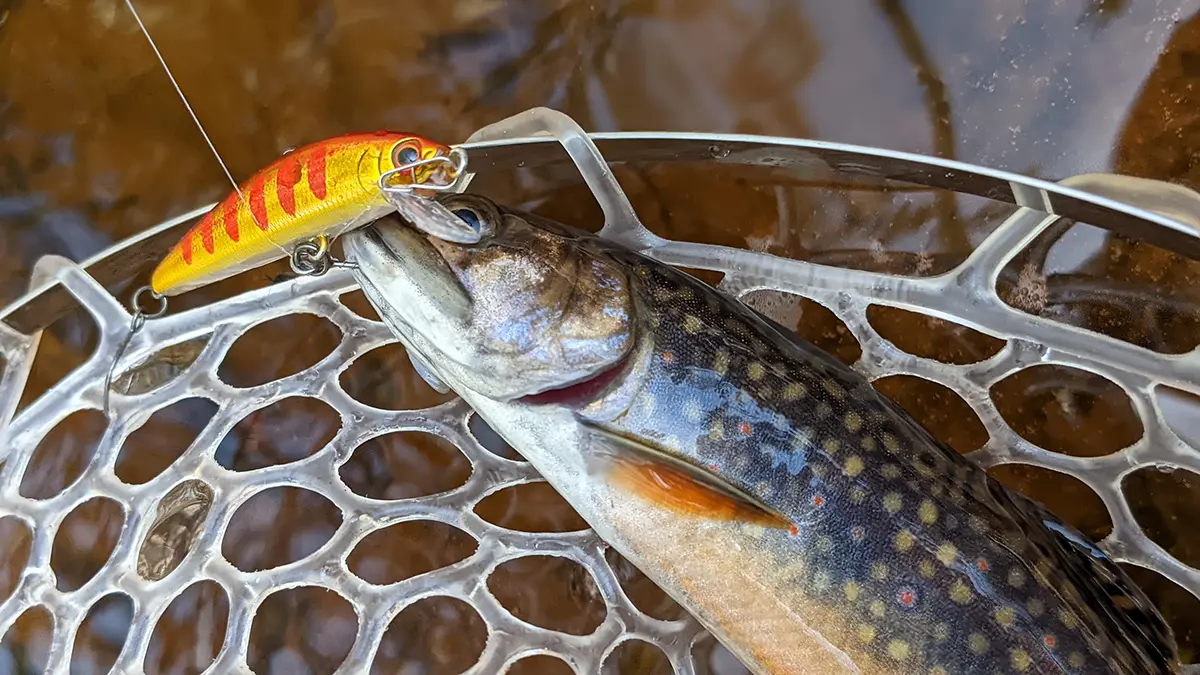
HOW TO CATCH BROOK TROUT
Brook trout make up for their smaller stature with their aggressive tendencies. Their willingness to bite live bait, hard lures and flies makes them among the easiest trout to catch. I have found brookies to be the easiest to catch of all those mentioned in this article. They are willing to pounce on just about anything that invades their space. how well an ecosystem is doing. Because they are usually tucked in brushy or rocky cover, I often use smaller trout minnows such as the Jackson Meteora 45 and Rapala CD-01 to trigger strikes while remaining less prone to snags. Minnow-style lures come through cover better than most lures and have fish-drawing power to coax a hostile brook trout to crush with vengeance. Use a lightweight spinning rod, or try using the bait finesse system for trout.
If you are looking to try your hand at fly fishing, brook trout are great because they are the most willing to hit a variety of flies. I like to use dry flies due to the acrobatic nature of them. Dry flies will often be my backup when conventional tackle such as minnows, inline spinners and jigs aren’t working. I pack a small collapsible tenkara rod to work the flies. This can build your confidence and you’ll also have a ton of fun watching these colorful beauties dart from seemingly nowhere to ambush your floating offering.
LAKE TROUT
Taking a turn to deeper waters, lake trout are often at home in deep lakes and reservoirs across North America. Native to Canada and the Great Lakes region of the United States, they require cold, deep and well-oxygenated waters to survive. Like the brookie above, they are also members of the Salvelinus genus, which makes them char as well. Unusual among trout, lakers that live in areas without much forage species of fish will primarily live by consuming plankton. These fish grow much slower and do not get nearly as big as lake trout that live in waters with abundant forage.
Many waters where I fish have both the “common lake trout” and “siscowet” subspecies of lake trout. Common lake trout are smaller and generally stay “trout-shaped” through adulthood. Siscowet lake trout grow much larger and sport massive bellies compared to the common lake trout. The Siscowet variety mostly reside in the Great Lakes and live in extremely deep waters, only coming relatively shallow during the prespawn period and head back into the depths after spawning. Regardless of type, lakers also are odd because they have a deeply forked tail compared to other types of trout.
HOW TO CATCH LAKE TROUT
Starting in late summer, lake trout will feed heavily before they spawn in the fall. They often come into shallow portions of the lake to feast on young alewives, perch and whatever other forage they can fit in their mouths. Anglers target these shallow areas that are holding baitfish and jig with large plastics, fish cut bait or speed troll through these areas. Many anglers catch their biggest laker ever during this time, due to the size of lake trout encountered during these periods.
Trolling is the most popular method to target these behemoth predators. Anglers will use large weights called downriggers to fish depths to over 200 feet to come across roaming lake trout. Most boat setups are quite specialized for such deep trolling and people often find themselves “committing” to big lake fishing once they invested the time and money into specifically targeting trout in the Great Lakes.
Vertical jigging is becoming more popular for targeting lakers and other trout in deep water. Anglers can use spinning or casting rods to drop jigs from 1/2 to 1 ounce or heavier into schools of bait. The action can be fast if schools of lakers are encountered. Ice fishing is also a great way to catch lake trout. Tip ups are the most traditional way of targeting lakers on the ice, but you can also use jigs or cut bait. Just make sure you have a stout rod.
LAKERS FOR DINNER?
As table fare, really large lake trout are often considered too greasy or mushy to eat. Most anglers will keep lakers under 15 pounds if harvesting. Fish larger than that are often considered good breeding fish, so releasing them greatly helps lake trout populations sustain themselves. Factors such as warming waters, reduced forage, invasive lamprey and others still negatively affect lake trout populations in areas.
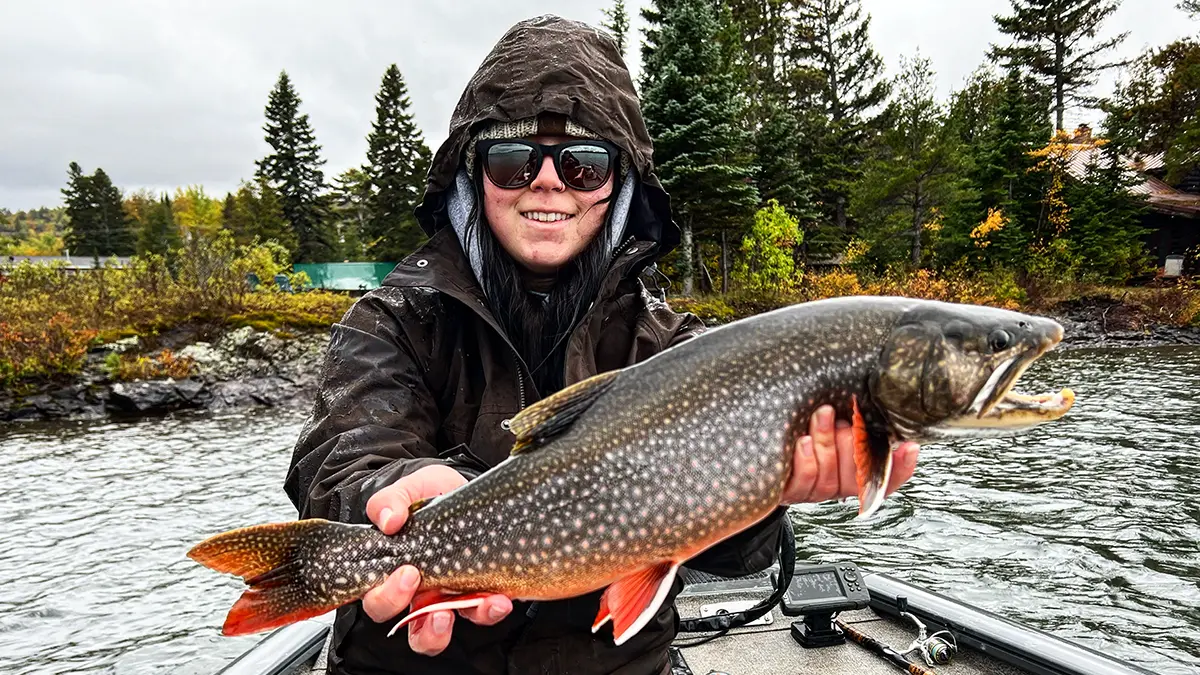
SPLAKE
Splake are a hybrid species often made at hatcheries from a female lake trout and male brook trout. They are fast-growing and do well in a variety of waters. Their average size is about 18 to 20 inches, but many will grow to over 25 inches in large bodies of water. Due to many factors, splake can grow as much as 18 inches in just two years after being planted as fingerlings. They primarily target minnows when past the fingerling stage, with crustaceans making up a small part of their diet. Splake are aggressive like a brook trout but can grow a bit larger thanks to the lake trout genetics.
Like most hybrids, splake rarely have the ability to spawn. Because of this, they have been successfully used to reduce populations of stunted perch in small to medium lakes. The ecological consequence is pretty low, due to splake’s inability to reproduce and that perch’s incredible ability to do so. This yields a much bigger average size for perch and the spread of fish borne diseases and parasites.
HOW TO CATCH SPLAKE
Splake will make a push up to shallow waters in the fall time like their parent species. But they seem to get stuck in a prespawn pattern for much longer than fish that are actually spawning. I take advantage of this time of year and fish breaklines near shallow flats to find schools of splake looking for an easy meal. Fall time, splake are often schooled up in groups of 5 to 20 fish and compete with each other like smallmouth do.
Targeting splake in the summer takes patience and usually deeper trolling or jigging. I like using minnow-ish shaped jigs like the Z-Man TRD TubeZ or a smaller curly-tailed grub. The fish are more dispersed as well, so expect to cover a lot of water if you’re looking to catch numbers. I never found lure color to be a huge factor. I usually use silver, blue or a yellow perch color and have caught fish year round.
Fall time, I will use fast moving baits like small crankbaits such as the Rapala Ultra Light series or smaller jerkbaits. Once I get a general sense of the depths they are in, I burn hard lures through those areas in order to effectively work that school before moving to the next one. I find myself getting any stragglers with minnow-imitating soft plastics and usually get my bigger fish that way.
SPLAKE THROUGH THE ICE
If targeting splake, or most trout for that matter, though the ice, try fishing shallow and aggressively jig small spoons or minnow style lures such as the Rapala Jigging Rap on shallow flats near transition areas to deep water. Set tip-ups or deadstick rigs on the transitions and you will have your bases covered. Hop around with your jigging rod and you will cross paths with trout. They cover a lot of water under the ice and your chances are pretty good you will hook into one.
OTHER COOL TROUT
There are a few “under the radar” trout species. These are either rare or have a secluded population that do not get the spotlight as much as the species listed above. These are often bucket list species for trout enthusiasts. Many states, such as Arizona, have “Grand Slam” challenges anglers can complete to be recognized by state departments of natural resources. These often require the angler to catch all species of trout living in the state in the same year to qualify. Angler challenge programs can bring recognition and awareness to fragile populations of fish, increasing support and conservation efforts to protect trout populations.
Many of these species live in the desert streams of Arizona and California. Arizona has the Apache and Gila trout while California has the California golden trout and the Paiute cutthroat. There are other obscure trout in other areas as well. Most of these rare fish live in small highland streams that are incredibly secluded and fragile.
Many of these species are at risk of becoming “genetically extinct” due to hybridization of rainbows and other planted fish not native to their waters. Catch-and-release, closed fishing seasons and other conservation practices are helping these populations rebound. Many species look similar and require a depth of knowledge to know if a trout caught is a hybrid or pure species. Anglers are encouraged to learn the difference and oftentimes are asked to report sightings to local fisheries managers.
WHAT ARE YOU WAITING FOR?
Trout fishing is not all that different from fishing for bass, bluegill or any other fish. Knowing when they spawn, what they are eating and how weather affects them is 90% of the game. The particulars such as tackle and technique are generally angler’s choice and play a less significant role than planning out your trip and targeting areas that hold active fish.
The next time it is too windy or cold to fish for your favorite warm water species, take a trip to a local stream and try your hand at catching some trout. The change of pace will be appreciated and you just might find more excuses to venture off the beaten path



